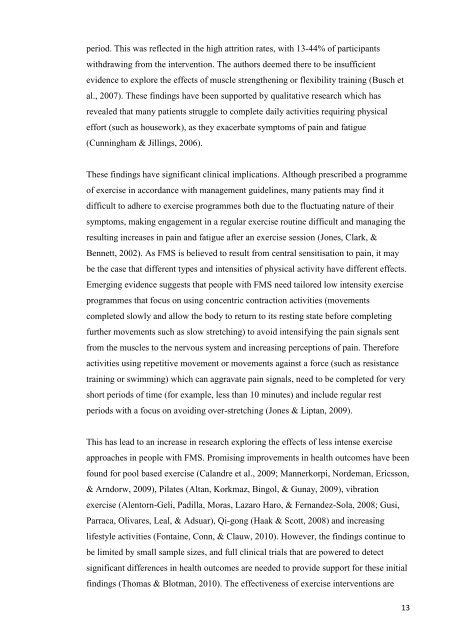Sick and Tired: Understanding and Managing Sleep Difficulties in ...
Sick and Tired: Understanding and Managing Sleep Difficulties in ...
Sick and Tired: Understanding and Managing Sleep Difficulties in ...
Create successful ePaper yourself
Turn your PDF publications into a flip-book with our unique Google optimized e-Paper software.
period. This was reflected <strong>in</strong> the high attrition rates, with 13-44% of participants<br />
withdraw<strong>in</strong>g from the <strong>in</strong>tervention. The authors deemed there to be <strong>in</strong>sufficient<br />
evidence to explore the effects of muscle strengthen<strong>in</strong>g or flexibility tra<strong>in</strong><strong>in</strong>g (Busch et<br />
al., 2007). These f<strong>in</strong>d<strong>in</strong>gs have been supported by qualitative research which has<br />
revealed that many patients struggle to complete daily activities requir<strong>in</strong>g physical<br />
effort (such as housework), as they exacerbate symptoms of pa<strong>in</strong> <strong>and</strong> fatigue<br />
(Cunn<strong>in</strong>gham & Jill<strong>in</strong>gs, 2006).<br />
These f<strong>in</strong>d<strong>in</strong>gs have significant cl<strong>in</strong>ical implications. Although prescribed a programme<br />
of exercise <strong>in</strong> accordance with management guidel<strong>in</strong>es, many patients may f<strong>in</strong>d it<br />
difficult to adhere to exercise programmes both due to the fluctuat<strong>in</strong>g nature of their<br />
symptoms, mak<strong>in</strong>g engagement <strong>in</strong> a regular exercise rout<strong>in</strong>e difficult <strong>and</strong> manag<strong>in</strong>g the<br />
result<strong>in</strong>g <strong>in</strong>creases <strong>in</strong> pa<strong>in</strong> <strong>and</strong> fatigue after an exercise session (Jones, Clark, &<br />
Bennett, 2002). As FMS is believed to result from central sensitisation to pa<strong>in</strong>, it may<br />
be the case that different types <strong>and</strong> <strong>in</strong>tensities of physical activity have different effects.<br />
Emerg<strong>in</strong>g evidence suggests that people with FMS need tailored low <strong>in</strong>tensity exercise<br />
programmes that focus on us<strong>in</strong>g concentric contraction activities (movements<br />
completed slowly <strong>and</strong> allow the body to return to its rest<strong>in</strong>g state before complet<strong>in</strong>g<br />
further movements such as slow stretch<strong>in</strong>g) to avoid <strong>in</strong>tensify<strong>in</strong>g the pa<strong>in</strong> signals sent<br />
from the muscles to the nervous system <strong>and</strong> <strong>in</strong>creas<strong>in</strong>g perceptions of pa<strong>in</strong>. Therefore<br />
activities us<strong>in</strong>g repetitive movement or movements aga<strong>in</strong>st a force (such as resistance<br />
tra<strong>in</strong><strong>in</strong>g or swimm<strong>in</strong>g) which can aggravate pa<strong>in</strong> signals, need to be completed for very<br />
short periods of time (for example, less than 10 m<strong>in</strong>utes) <strong>and</strong> <strong>in</strong>clude regular rest<br />
periods with a focus on avoid<strong>in</strong>g over-stretch<strong>in</strong>g (Jones & Liptan, 2009).<br />
This has lead to an <strong>in</strong>crease <strong>in</strong> research explor<strong>in</strong>g the effects of less <strong>in</strong>tense exercise<br />
approaches <strong>in</strong> people with FMS. Promis<strong>in</strong>g improvements <strong>in</strong> health outcomes have been<br />
found for pool based exercise (Cal<strong>and</strong>re et al., 2009; Mannerkorpi, Nordeman, Ericsson,<br />
& Arndorw, 2009), Pilates (Altan, Korkmaz, B<strong>in</strong>gol, & Gunay, 2009), vibration<br />
exercise (Alentorn-Geli, Padilla, Moras, Lazaro Haro, & Fern<strong>and</strong>ez-Sola, 2008; Gusi,<br />
Parraca, Olivares, Leal, & Adsuar), Qi-gong (Haak & Scott, 2008) <strong>and</strong> <strong>in</strong>creas<strong>in</strong>g<br />
lifestyle activities (Fonta<strong>in</strong>e, Conn, & Clauw, 2010). However, the f<strong>in</strong>d<strong>in</strong>gs cont<strong>in</strong>ue to<br />
be limited by small sample sizes, <strong>and</strong> full cl<strong>in</strong>ical trials that are powered to detect<br />
significant differences <strong>in</strong> health outcomes are needed to provide support for these <strong>in</strong>itial<br />
f<strong>in</strong>d<strong>in</strong>gs (Thomas & Blotman, 2010). The effectiveness of exercise <strong>in</strong>terventions are<br />
13

















